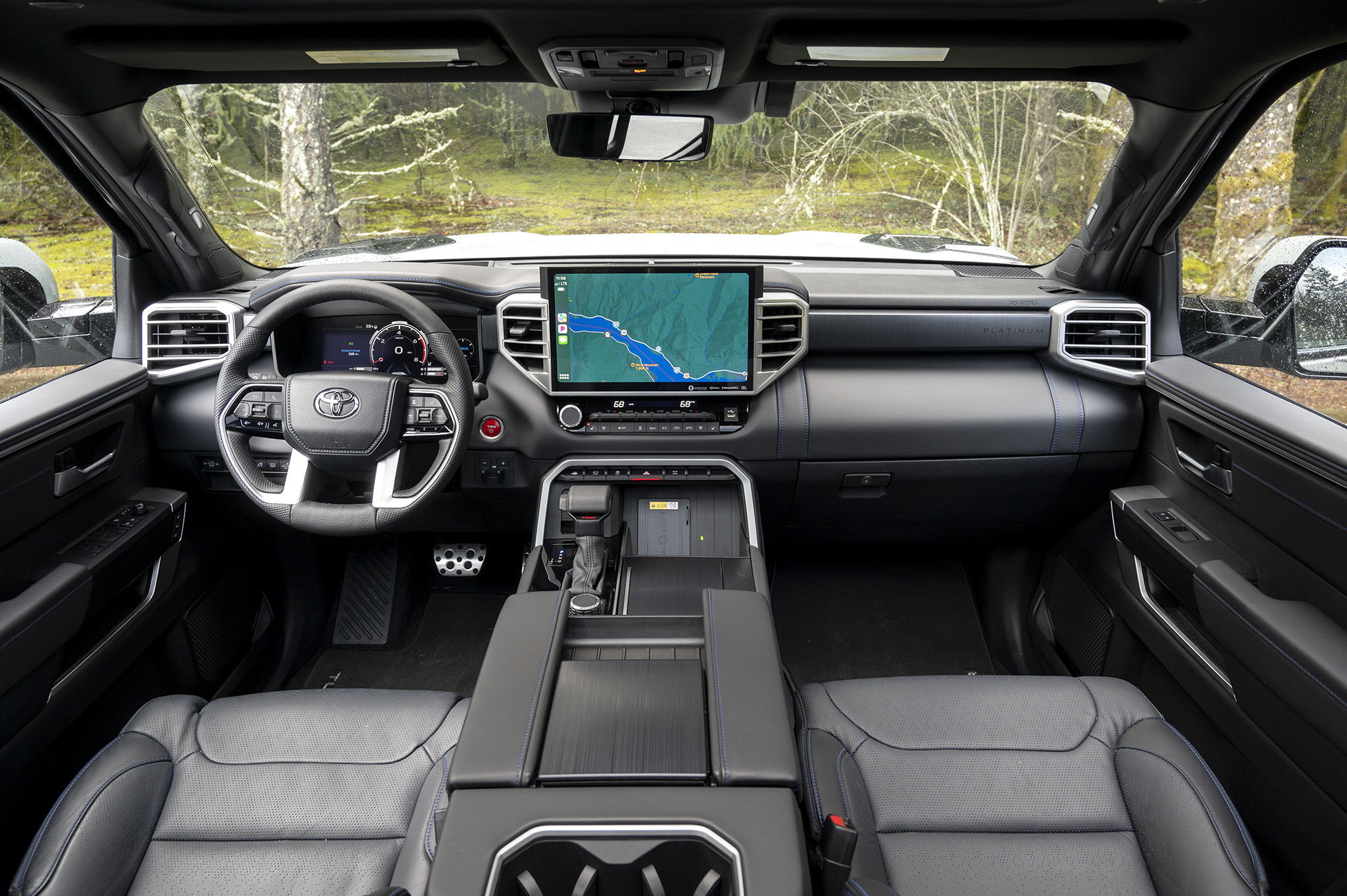Toyota Tundra : Toyota owners across America are dealing with a serious situation right now. The Japanese automaker has announced a massive safety recall that affects hundreds of thousands of Tundra pickup trucks. This isn’t just another minor issue that can wait – it’s something that could put drivers and their families at real risk.
The recall covers 443,000 Toyota Tundra and Tundra Hybrid vehicles from model years 2022 through 2025. That’s nearly half a million trucks that need immediate attention from their owners. What makes this particularly concerning is that the problem involves a critical safety component that drivers rely on every single day.
Understanding the Critical Component Failure
The heart of this recall centers around the reverse lamp assemblies on affected Tundra trucks. These aren’t just decorative lights – they serve a crucial safety function that many drivers take for granted. When you shift your truck into reverse, these lamps should automatically illuminate to warn pedestrians and other drivers that your vehicle is backing up.
Moisture intrusion is the culprit behind this widespread failure. Over time, water has been seeping into the lamp assemblies, causing both reverse lights to stop working completely. This might sound like a minor inconvenience, but the safety implications are far more serious than most people realize.
Why This Matters More Than You Think
Think about the last time you backed out of a parking space in a dimly lit area. Without functioning reverse lights, other drivers have no visual cue that your truck is moving backward. Pedestrians walking behind your vehicle might not realize you’re about to back up. This communication breakdown between your vehicle and the outside world creates dangerous situations.
The National Highway Traffic Safety Administration (NHTSA) takes these issues seriously because they involve what experts call “conspicuity.” That’s a fancy word meaning how visible and noticeable your vehicle is to others. When safety features fail, the risk of accidents increases dramatically.
The Technical Details Behind the Problem
Engineers at Toyota discovered that the lamp assembly design wasn’t adequately protecting internal components from moisture. Water vapor gradually worked its way into the housing, where it caused corrosion and electrical failures. The problem appears to be systemic rather than isolated incidents.
What’s particularly frustrating for owners is that this failure often happens without any warning signs. One day the lights work fine, and the next day they’re completely dead. There’s no gradual dimming or intermittent operation that might alert drivers to the developing problem.
Previous Recalls That Raised Red Flags

This latest recall isn’t happening in isolation. Toyota Tundra trucks have faced multiple safety recalls over the past two years, which has left many owners questioning the overall reliability of their vehicles. Understanding this pattern helps explain why the current situation feels so concerning to truck owners.
The Engine Machining Debris Crisis
In May 2024, Toyota recalled 102,000 Tundra trucks from model years 2022 and 2023 due to a manufacturing defect that could cause complete engine failure. The problem involved machining debris that wasn’t properly cleaned from engines during production. This metal debris could cause engine knocking, rough running, or total power loss while driving.
The solution was dramatic – Toyota agreed to replace entire engines at no cost to customers. That’s an expensive fix that typically costs tens of thousands of dollars. The fact that Toyota was willing to absorb these costs demonstrates how serious the safety risk was.
Transmission Software Glitches
Earlier in 2024, another recall affected 280,000 Toyota vehicles including Tundra trucks. This time, the problem involved transmission software that wouldn’t properly disengage when drivers shifted into neutral. The result was unintended vehicle movement, which could cause crashes in parking lots or driveways.
These software-related issues highlight how modern trucks rely heavily on computer systems. When these systems fail, the consequences can be both unexpected and dangerous for drivers who aren’t prepared for such malfunctions.
What Tundra Owners Need to Do Right Now
If you own a Toyota Tundra from model years 2022 through 2025, you need to take action immediately. Don’t wait for a letter in the mail or assume someone else will handle this for you. Your safety and the safety of others depends on addressing this recall promptly.
Step One: Check Your Vehicle’s Status
The first thing you should do is verify whether your specific truck is affected by this recall. Toyota has set up online tools that make this process straightforward. Visit Toyota.com/recall and enter your Vehicle Identification Number (VIN). You can find this 17-digit code on your dashboard near the windshield or on your vehicle registration paperwork.
You can also check the NHTSA website at nhtsa.gov/recalls for the same information. Both sources will give you definitive answers about whether your truck needs service. Don’t rely on general model year information – use your specific VIN to get accurate results.
Step Two: Contact Your Local Toyota Dealer
Once you’ve confirmed that your truck is affected, call your nearest Toyota dealership to schedule service. Don’t delay this call – dealerships are likely to get busy as more owners become aware of the recall. Getting on the schedule early means you’ll get your truck fixed sooner.
When you call, have your VIN ready and mention that you’re calling about recall number 25TA08 (the official Toyota recall code for this issue). This helps the service department quickly understand your needs and schedule appropriate repair time.
Understanding the Repair Process
Toyota has committed to replacing both reverse lamp assemblies with improved versions that better resist moisture intrusion. The work also includes inspecting and potentially repairing wiring harnesses if corrosion has spread beyond the lamp housings. All repairs are covered at no cost to vehicle owners.
The dealership will provide you with a repair timeline when you schedule your appointment. Most lamp replacements can be completed in a few hours, but if wiring harness work is needed, the repair might take longer.
The Broader Impact on Toyota’s Reputation

This recall comes at a challenging time for Toyota’s reputation in the truck market. The company has built its brand on reliability and dependability, but multiple recalls affecting the same vehicle model raise questions about quality control processes.
Financial Implications for the Company
Recalls of this magnitude are expensive for automakers. Toyota will spend millions of dollars on replacement parts, dealer labor costs, and administrative expenses. The company also faces potential legal liability if accidents occur due to the defective reverse lamps.
Beyond immediate costs, there’s also the long-term damage to brand reputation. Toyota truck buyers have traditionally been loyal customers who expect their vehicles to work properly for many years. When multiple recalls affect the same model, that loyalty can erode quickly.
Competition Takes Notice
Other truck manufacturers are certainly watching how Toyota handles this situation. Ford, Chevrolet, and Ram compete directly with the Tundra, and they’ll likely use Toyota’s quality issues in their marketing efforts. This competitive pressure adds urgency to Toyota’s need to resolve these problems quickly and thoroughly.
The truck market is particularly competitive right now, with new models and technologies being introduced regularly. Toyota can’t afford to lose market share due to quality concerns when competitors are offering attractive alternatives.
Safety Tips While Waiting for Repairs
If your truck is affected by this recall but you can’t get it repaired immediately, there are steps you can take to minimize safety risks while you wait for service. These temporary measures won’t solve the underlying problem, but they can help prevent accidents.
Practice Extra Caution When Backing Up
Without functioning reverse lights, you need to be even more careful when backing up your truck. Look over your shoulder instead of relying solely on mirrors or backup cameras. Take extra time to scan for pedestrians, especially children who might not be visible in your mirrors.
Consider using your hazard lights when backing up in busy areas. While this isn’t a perfect substitute for reverse lights, it does provide some visual warning to others that your vehicle is maneuvering. Turn off the hazards as soon as you complete your backing maneuver.
Avoid Backing Up in Low-Light Conditions
Whenever possible, avoid backing up when visibility is poor. This means being more strategic about parking choices, especially during evening hours or in poorly lit areas. Try to park in spots where you can drive forward when leaving.
If you must back up in low-light conditions, consider having someone spot for you by standing where they can watch for pedestrians and other vehicles. Make sure your spotter stays in a safe position and uses clear hand signals to guide you.
Legal Rights and Options for Owners
Toyota truck owners affected by this recall have certain legal rights and protections under federal law. Understanding these rights can help you navigate the repair process and seek additional compensation if necessary.
Right to Free Repairs
Federal law requires automakers to fix safety-related defects at no cost to vehicle owners, regardless of warranty status or vehicle age. This means Toyota must provide parts and labor for free, even if your truck is several years old or has high mileage.
You also have the right to have repairs completed at any authorized Toyota dealership, not just the one where you purchased your vehicle. This flexibility can be helpful if you’ve moved or if your local dealer has long wait times for service appointments.
Potential for Additional Compensation
In some cases, owners may be entitled to reimbursement for expenses related to recall defects. This could include rental car costs if your truck is unsafe to drive, or repair costs if you paid to fix the problem before the recall was announced.
If you believe the defective reverse lights contributed to an accident or property damage, you should document everything carefully and consider consulting with an attorney who specializes in automotive defect cases. Keep all repair receipts, insurance claims, and correspondence related to the issue.
Prevention and Future Considerations
While current owners need to address this recall immediately, the situation also raises important questions about preventing similar problems in the future. Toyota and other automakers can learn valuable lessons from this experience.
Improved Quality Control Processes
This recall highlights the importance of thorough testing during vehicle development. Moisture intrusion problems should be caught during the design phase, not after hundreds of thousands of vehicles have been sold to customers.
Toyota will likely implement enhanced testing protocols for future lamp assemblies and other exterior components. This might include extended moisture exposure tests that simulate years of real-world use in various weather conditions.
Better Communication with Owners
One positive aspect of this recall is Toyota’s proactive communication with customers. The company announced the recall promptly and provided clear information about the safety risks involved. This transparency helps build trust even during difficult situations.
Future recalls will likely benefit from improved digital communication methods, including text messages, emails, and mobile app notifications. These modern communication channels can reach owners more quickly than traditional mail.
FAQs
Q: How do I know if my Toyota Tundra is affected by this recall?
Visit Toyota.com/recall or nhtsa.gov/recalls and enter your 17-digit VIN number to check your vehicle’s specific status.
Q: Will Toyota pay for rental cars while my truck is being repaired?
Contact your local Toyota dealership to ask about rental car coverage during recall repairs, as policies may vary by location.
Q: Can I still drive my Tundra safely until it gets repaired?
Exercise extra caution when backing up, avoid low-light backing situations when possible, and schedule repairs as soon as available appointments allow.

